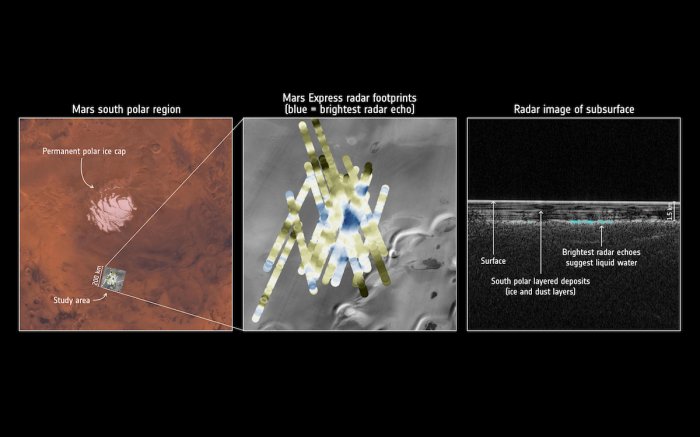ESA’s Mars Express Detects Liquid Water Under Surface Of Mars’ South Pole
A pond of liquid water buried under layers of ice and dust in the south polar region of Mars has been revealed by radar data collected by ESA’s Mars Express.
Evidence for the Red Planet’s watery past is widespread across its surface in the form of vast dried-out river valley networks, minerals that can only form in the presence of liquid water and gigantic outflow channels clearly imaged by orbiting spacecraft. The presence of liquid water at the base of the polar ice caps has long been suspected.

Water detection under the south pole of Mars. Credit: Context map: NASA/Viking; THEMIS background: NASA/JPL-Caltech/Arizona State University; MARSIS data: ESA/NASA/JPL/ASI/Univ. Rome; R. Orosei et al 2018
But the climate has changed significantly over the course of the planet’s 4.6 billion year history and liquid water cannot exist on the surface today, so scientists are looking underground.
But until now the discovered evidence from the Mars Advanced Radar for Subsurface and Ionosphere Sounding instrument, MARSIS, remained inconclusive.
It was therefore necessary to develop new techniques in order to collect as much high-resolution data as possible to confirm their exciting conclusion.
Ground-penetrating radar shows that South Polar Region of Mars is made of many layers of ice and dust down to a depth of about 1.5 km in the 200 km-wide area analyzed in this study. A particularly bright radar reflection underneath the layered deposits is identified within a 20 km-wide zone.
The scientists interpret the bright feature as an interface between the ice and a stable body of liquid water, which could be laden with salty, saturated sediments.
“This subsurface anomaly on Mars has radar properties matching water or water-rich sediments,” says Roberto Orosei, principal investigator of the MARSIS experiment and lead author of the paper.
“This is just one small study area; it is an exciting prospect to think there could be more of these underground pockets of water elsewhere, yet to be discovered.”
The finding is somewhat reminiscent of Lake Vostok, discovered some 4 km below the ice in Antarctica on Earth. Some forms of microbial life are known to thrive in Earth’s subglacial environments, but could underground pockets of salty, sediment-rich liquid water on Mars also provide a suitable habitat, either now or in the past?
Whether life has ever existed on Mars remains an open question, and is one that Mars missions, including the current European-Russian ExoMars orbiter and future rover, will continue to explore.
Mars Express launched 2 June 2003 and celebrates 15 years in orbit on 25 December this year.



 Creators of mankind
Creators of mankind Description of “Tall white aliens”
Description of “Tall white aliens” Where they came from?
Where they came from? About hostile civilizations
About hostile civilizations The war for the Earth
The war for the Earth “Tall white aliens” about eternal life
“Tall white aliens” about eternal life Video: “Nordic aliens”
Video: “Nordic aliens” Aliens
Aliens Alien encounters
Alien encounters The aliens base
The aliens base UFO
UFO Technology UFO
Technology UFO Underground civilization
Underground civilization Ancient alien artifacts
Ancient alien artifacts Military and UFO
Military and UFO Mysteries and hypotheses
Mysteries and hypotheses Scientific facts
Scientific facts


















